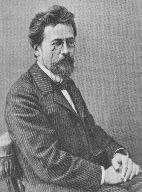The Well-Made Plot of The Cherry Orchard |
|
| In reading Chekhov, it may seem like, initially,
nothing happens. However, with closer attention (and often a second read), it becomes
clear that much is going on and that Chekhov has carefully plotted the exchanges between
characters. He often uses the pressures of public social situations to bring out differing
sides of his characters, such as arrivals, departures, and dances.
In Act I, we are introduced to the characters and their relationships with each other. We learn that the estate of Ranevskaya (newly arrived from Paris) and her brother Gayev is to be sold to pay their debts. We find that Varya, Ranevskaya’s adopted daughter, is in charge of running the place. We meet the rich merchant Lopahin, child of serfs, who has a plan to chop down the cherry orchard, erect summer vacation homes, and use the rent to keep the estate afloat financially. We learn that Ranevskaya lost her husband and son several years ago, and we eventually learn that Gayev has a plan to ask the family’s rich aunt for the money to pay the interest. We are introduced to the various romances, which play a subsidiary role in the overall play: the maid Dunyasha’s interest in the fashionable valet Yasha, the interest of Varya in Lopahin, who seems too preoccupied with business ventures, and the interest of the student Trofimov in Ranevskaya’s younger daughter Anya. We also meet the secondary characters, often farcical in nature: Pishchik, a boorish if laughable landowner; Yepihodov, an exaggerated, problem-ridden clerk working for the estate; Firs, the elderly manservant who remembers the days before the serfs were freed; and Charlotta, a priggish governess.
Act II opens in a meadow in which we see several characters engage in fairly broad farce that reveals their emotional states: we see Charlotta’s regret over her lack of identity (complete with cucumber in hand); we see Yepihodov’s pretensions to culture; we learn more about Dunyasha’s interest in Yasha; and we see Lopahin’s incredulity grow that Ranevskaya and Gayev have so little sense of what’s to be done about their estate. Ranevskaya reveals her poor choices in love: her husband’s debt-ridden decadent drunkenness and her later lover’s abuse and abandonment of her for another woman. We learn that Ranevskaya approves of a marriage between Varya and Lopahin, but that he seems strangely reluctant. We encounter the idealism of Trofimov about the future of Russian society in the face of class divisions and rampant poverty, as well as Lopahin’s more pragmatic belief in the progress of industry. We learn, on the other hand, that some like Firs regard the changes of the recent past as "the calamity" (1554). And we learn that Anya shares in Trofimov’s idealism.
Act III takes place between an evening ballroom dance and an adjacent drawing-room where a billiards game is being held. (It opens with an effective farcical exchange between Pishchik and Trofimov.) All the characters are enjoying themselves but also in suspense about the pending sale of the orchard. Several issues surrounding love-relationships unfold: Trofimov teases Varya about Lopahin; Ranevskaya learns that her Paris lover will take her back and longs to go to him; Ranevskaya in turn teases Trofimov about his own lack of sexual experience and idealism about romance; and we later learn that Dunyasha scorns Yepihodov's affections. We watch as Yasha dismisses Firs for his extreme age, and we learn of Yasha’s desire to return to Europe with Ranevskaya. Varya fires Yepihodov for breaking a cuestick in the billiards game. The central event of the third act and quite possibly the play, however, is Lopahin’s announcement that he has bought the orchard himself at the auction.
In Act IV, we watch the departure of all the characters, the majority of whom are surprisingly happy. Trofimov is to return to Moscow to study; Anya as well is to continue in her studies and looks to the future with hope and expectation; Ranevskaya seems relieved to be returning to Paris to live off her aunt’s money; Gayev has taken the job offered him with the bank; Pishchik has come into money because of English investments in his property’s white clay; Yepihodov has been reinstated by Lopahin; even Charlotta seems happy. Of course, sadness surrounds the loss of the orchard, especially for Ranevskaya and Gayev. Varya is also sad but has taken a job as a housekeeper. (There is a possible hint that Lopahin has proposed marriage and that Varya will eventually accept, cf. 1570.) Only Firs, who was away at the hospital, is finally left behind, and the play ends with his return to find everyone else departed.
We can see, then, in Chekhov's play, despite its seemingly random, atmospheric conversations, a classical, dramatic structure:
|
|
